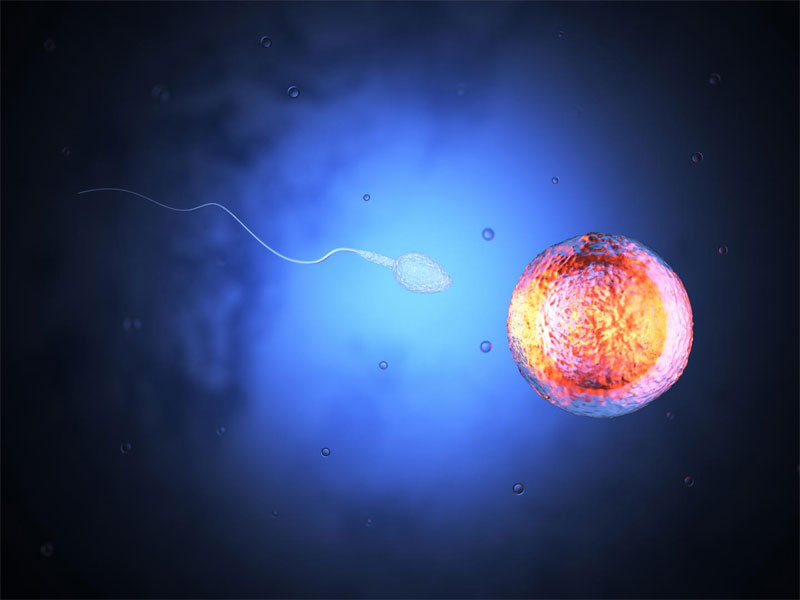'Spermbot' May One Day Help Treat Cervical Cancer

A biohybrid sperm microrobot might one day deliver anti-cancer drugs to tumors in the female reproductive tract, according to a new paper from Germany.
The sci-fi-sounding microbot, which was described in a December article in the journal ACS Nano, consists of sperm from a bull combined with a plastic, 3D-printed microstructure covered with an iron-based coating.
This coating allows the researchers to magnetically steer the robot to the target. Then, when the biohybrid bot hits the tumor, four arms on the microstructure automatically bend, releasing the sperm cell, which penetrates the cancer cells and delivers its medical cargo. [Super-Intelligent Machines: 7 Robotic Futures]
The technology is still far from being ready for practical applications — so far, it's only been tested in lab dishes, and much more research is needed before it could be tried in humans.
Though "spermbots" may seem like an odd way to deliver drugs to certain locations in the body, the researchers said that sperm are a natural fit for the job.
"We decided to work with sperm cells because they have the ability to naturally swim in the female reproductive tract," said study co-author Mariana Medina-Sánchez, leader of the Micro- and Nanobiomedical Engineering Group at the Institute for Integrative Nanosciences in Dresden, Germany.
"The sperm has the natural ability to fuse with the [egg cell], and this is very beneficial," Medina-Sánchez told Live Science. "It can do the same thing with the cancer cells and release the drug inside the cancer cells, making the treatment much more effective."
Sign up for the Live Science daily newsletter now
Get the world’s most fascinating discoveries delivered straight to your inbox.
In the study, the researchers loaded a cervical cancer drug, called doxorubicin hydrochloride into the head of the sperm cell, Medina Sánchez said. The sperm head protects the drug from the surrounding environment, she said. In addition, the drug doesn’t affect the sperm cells in the same way that it affects cancer cells, so the sperm cell stays healthy and is able to move around, she said.
The drug-carrying spermbots were tested in lab dishes, where they were tasked with delivering the drugs to cervical cancer cells.
The researchers said that they hope to move to animal experiments in the future. And at some point, they will have to replace the bull sperm with a human sperm, Medina-Sánchez said.
From lab cells to humans?
Though the lab-based experiments were successful — the spermbot was guided to the cervical cancer cells, where the sperm was released and delivered the cancer drug — there are still some challenges that the researchers are trying to address, Medina-Sánchez said.
For example, the researchers "want to make the [iron-coated plastic] structure biodegradable so that it dissolves after the release of the drug, Medina-Sánchez said. This adjustment would help "to avoid immunological and other reactions these structures could possibly cause."
At the moment, the researchers can only guide individual sperm cells. But for practical applications, they would need to be able to steer multiple sperm cells at the same time to deliver the right dose of the drug, since a single sperm cell can only hold so much. [Sexy Swimmers: 7 Facts About Sperm]
In practical applications, the sperm cells could be injected into the female reproductive system with a catheter — a method that's similar to artificial insemination, Medina-Sánchez said. The spermbots would still need to be guided magnetically, but the magnetic field used to control the bot is very weak and has no effect on the human body, she added.
In the study, the spermbots were tested using cervical cancer cells. But the researchers "want to use it for all types of gynecological cancers — ovarian cancer, cancer of the uterus, cervical cancer," Medina-Sánchez said.
Some further technological advances will be needed for the technology to make it into hospitals. Current imaging techniques are not precise enough to allow doctors to monitor in real time the motion of the sperm cyborgs inside the body, which is something they would want to do in clinical settings, she said.
"Ideally, we would like to visualize [the spermbots] in real-time in the deep tissue … to really bring [the bots] to the target position," Medina-Sánchez said. "But currently, the spatial resolution of magnetic resonance or ultrasound imaging systems is only about 100 micrometers."
The sperm’s head is 5 by 10 micrometers in size, Medina Sánchez said, and the 3D-printed microstructure is only slightly bigger, which means that the sperm cyborg would be invisible to current systems.
Originally published on Live Science.











